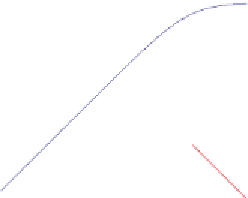Biology Reference
In-Depth Information
acid-base catalysis by an adenine and a guanine, and that the observed rates
of reaction could be achieved despite the penalty incurred in having p
K
a
values shifted from neutrality. However, the function of G8 has been con-
troversial, with some favoring the hypothesis that G8 performs a structural
role in which it contributes to the positioning of the nucleophile and stabi-
lizes the transition state. The origin of the controversy stems mainly from the
pH dependence of the hairpin ribozyme reaction rates. The pH dependence
of the ribozyme superficially appears to correspond to a single p
K
a
for both
cleavage and ligation, typically near pH 6
73,83
(
Fig. 3.11
). In principle, this is
consistent with a single titratable group that could not plausibly be a guanine.
If the cleavage rate responded to the ionization of a single group then the pH
dependence should invert for the reverse (ligation) reaction, which is not
observed.
73,83
On the other hand, if the pH dependence results from the
ionization of two groups (even though the upper p
K
a
may be too high to
1
1
f
B
(p
f
A
f
B
f
A
(p
K
a
= 6)
f
A
f
B
f
A
(p
K
a
= 5.2)
K
a
= 10
)
f
B
(p
K
a
= 8.5)
10
-
2
10
-
2
10
-
4
f
A .
f
B
10
-
4
f
A .
f
B
f
A .
f
B
f
A .
f
B
10
-
6
10
-
6
4
5
6
7
8
9
10
4
5
6
7
8
9
10
pH
pH
Figure 3.11 Simulations of the pH dependence of substrate cleavage reactions by the
VS and hairpin ribozymes. Active ribozyme requires a protonated acid (fraction f
A
) and
an unprotonated base (fraction f
B
), and the reaction rate at a given pH will be propor-
tional to the product f
A
f
B
. These values have been calculated for two sets of values
reflecting the VS ribozyme (acid pK
a
¼5.2; base pK
a
¼8.5; shown left) and the hairpin
ribozyme (acid pK
a
¼6; base pK
a
¼10; shown right). The values f
A
(red), f
B
(blue), and
f
A
f
B
(black) are plotted on a logarithmic scale as a function of pH. The shaded regions
indicate extremes of pH where measurement of accurate rates is difficult. Note that the
simulation of the VS ribozyme cleavage rate gives a bell-shaped profile in the observ-
able region of pH. However, the high pK
a
of the base for the hairpin ribozyme means
that the reduction of f
A
f
B
occurs at pH values higher than that experimentally acces-
sible such that the cleavage rate appears to form a plateau at higher pH. The rate nev-
ertheless reflects the ionization of two groups.


























































Search WWH ::

Custom Search